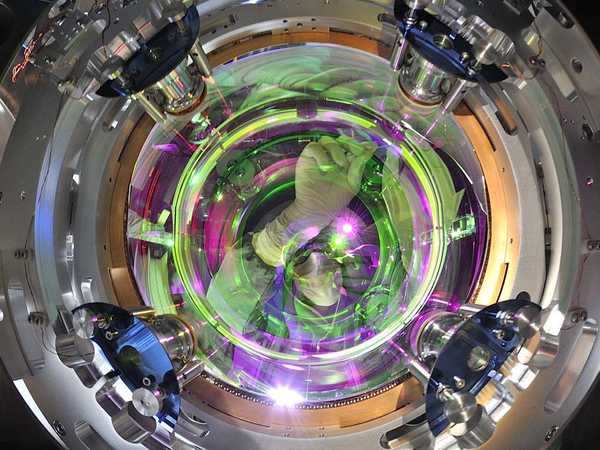A collision in #space revealed a #blackhole that physicists thought could never exist. The observatory that detected it cracked a 100-year-old mystery posed by #Einstein.
https://www.businessinsider.in/science/news/a-collision-in-space-revealed-a-black-hole-physicists-thought-could-never-exist-the-observatory-that-detected-it-cracked-a-100-year-old-mystery-posed-by-einstein-/articleshow/77895646.cms">https://www.businessinsider.in/science/n...
https://www.businessinsider.in/science/news/a-collision-in-space-revealed-a-black-hole-physicists-thought-could-never-exist-the-observatory-that-detected-it-cracked-a-100-year-old-mystery-posed-by-einstein-/articleshow/77895646.cms">https://www.businessinsider.in/science/n...
Seven billion years ago, two black holes crashed into each other and merged into one enormous #blackhole with the mass of 142 suns.
The collision reverberated through space and time, and these ripples — a phenomenon called gravitational waves first predicted by #AlbertEinstein — traveled 16.5 billion light-years through the universe, reaching #Earth in May 2019.
For one-tenth of a second, the waves stretched the mile-long arms of two enormous physics observatories: the Laser Interferometer Gravitational-Wave Observatory in the US and its Italian companion, Virgo.
The scientists behind these observatories immediately knew they& #39;d detected something unique. "This doesn& #39;t look much like a chirp, which is what we typically detect," Nelson Christensen, a Virgo scientist and a researcher at French National Center for Scientific Research, said.
The black-hole merger the observatories detected is the most massive and distant they& #39;ve ever picked up. But more strikingly, it defies the known laws of physics.
The scientists& #39; calculations showed that the heavier black hole of the two that crashed was 85 times the mass of the sun — falling within a range that many physicists thought impossible.
"This is exactly what I predicted wasn& #39;t there," Stan Woosley, an astrophysicist who models the deaths of massive stars (the process that creates black holes), told Business Insider. "A big black hole smack-dab in the middle of the forbidden zone."
Some of us will owe bottles of wine to others& #39;
Black holes form when heavy stars die and collapse; their gravitational pulls are so strong that not even light can escape.
Black holes form when heavy stars die and collapse; their gravitational pulls are so strong that not even light can escape.
There are two main types of #BlackHoles: stellar-mass (which are tens of solar masses) and supermassive (which have the mass of millions or even billions of suns).
The 142-solar-mass #blackhole that formed as a result of this 7-billion-year-old collision is the first detected that& #39;s between 100 and 1,000 solar masses. This "intermediate mass" object could reveal a missing link between the two types of black holes.
It may also help scientists understand where supermassive black holes come from.
But the 85-solar-mass black hole involved in the collision wasn& #39;t supposed to exist at all.
But the 85-solar-mass black hole involved in the collision wasn& #39;t supposed to exist at all.
Instead, physics models suggest that stars in that mass range should die in a unique type of supernova explosion that annihilates the star, leaving behind no material to collapse into a dense black hole.
The black hole could have grown from a previous collision
It& #39;s unlikely that this impossible black hole was created directly from a collapsing star, so some researchers think it could have come from a previous merger.
It& #39;s unlikely that this impossible black hole was created directly from a collapsing star, so some researchers think it could have come from a previous merger.
#Einstein& #39;s predictions led scientists to violent space collisions and a new realm of physics
Einstein predicted that collisions of massive objects, like black holes and neutron stars, would produce gravitational waves.
Einstein predicted that collisions of massive objects, like black holes and neutron stars, would produce gravitational waves.
But he didn& #39;t think anyone would ever detect these ripples in space-time — they seemed too weak to pick up on Earth amid all the noise and vibrations here.
For 100 years, it seemed Einstein was right.
For 100 years, it seemed Einstein was right.
But in the late 1990s, LIGO& #39;s machines in Washington and Louisiana were built in an attempt to pick up the signals. For the first 13 years, they waited in silence.
Finally, in September 2015, LIGO detected its first gravitational waves: signals from the merger of two black holes some 1.3 billion light-years away.
The discovery opened a new field of astronomy, and three researchers who helped conceive of the experiment earned a Nobel Prize in physics.
Since then, LIGO and Virgo have identified two other types of collisions. The observatories registered gravitational waves from two neutron stars merging for the first time in October 2017.
In August 2019, LIGO and Virgo detected what scientists believe was a black hole swallowing a neutron star.
Researchers expect to learn more as they delve further into this field of physics. Planned upgrades and new observatories may enable scientists to detect new space collisions every day by the mid-2020s.

 Read on Twitter
Read on Twitter


